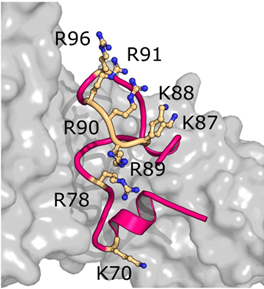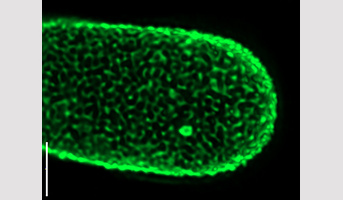When pectins and proteins meet: a new mechanism for assembling the plant wall
A question then arises: how can this wall grow, without losing its integrity, which would cause the cell to explode? To understand this mechanism, scientists analyzed in detail the assembly process of this wall.
To do this, they studied the growth of the pollen tube of the thale cress, a model plant. Its cell wall includes two major components, including fibers and a matrix, mainly made up of pectins. Pectins are well known for their role as a gelling agent in the making of jams!
The IJPB "Primary Cell Wall" PAR team had already discovered that once deposited in the wall, pectins swell, following an enzymatic transformation giving them negative charges, and allow the expansion of the wall.
Here the same team in collaboration with researchers from the BIA Unit, the IINS, the Universities of Lausanne & Zurich in Switzerland and the University of Antwerp in Belgium, shows that these negatively charged pectins form a complex with positively charged peptides present on the surface of a wall protein. This interaction induces the condensation of the pectin, thus creating a cross-linked pattern which confers both strength and extensibility to the wall. The pollen tube wall of plants carrying mutations in peptides, or in their protein partner, does not show this cross-linked structure and disintegrates prematurely. The formation of the peptide-protein-pectin complex and the condensation of pectins have also been demonstrated in vitro.

This study, which reveals the dual signaling and structural role of this peptide-protein-pectin complex to shape cell wall extension, is a source of inspiration for rationalizing new mechanisms of protein-polymer interactions. Beyond this, these results should facilitate the selection of new plant varieties adapted to climate change.
Finally, this work is a fine example of collaboration between the TRANSFORM and BAP INRAE divisions, which resulted in a first-rate scientific production.
Projects involved:
> ANR « HOMEOWALL » coordinated by Herman Höfte PAR team leader
> ERC Starting grant « STORMTHEWALL » from Kalina Haas, PAR team
Partners:
> The Plant Signaling Mechanisms Laboratory, Department of Plant Molecular Biology, University of Lausanne, 1015, Lausanne, Switzerland
> Université Paris-Saclay, INRAE, AgroParisTech, Institut Jean-Pierre Bourgin (IJPB),78000, Versailles, France
> Department of Plant Molecular Biology, University of Lausanne, 1015 Lausanne, Switzerland
> Electron Microscopy Facility, University of Lausanne, Lausanne, Switzerland
> UR Biopolymères, Interactions et Assemblages INRAE, UR1268 BIA, F-44300 Nantes, France
> Integrated Molecular Plant Physiology Research (IMPRES), Department of Biology, University of Antwerp, Groenenborgerlaan 171, 2020 Antwerp, Belgium
> Department of Plant and Microbial Biology & Zurich-Basel Plant Science Center, University of Zurich, 8008 Zurich, Switzerland
> IINS, CNRS UMR5297, University of Bordeaux, 33000 Bordeaux, France
Back

Legend: 3D image of a molecularly labeled Arabidopsis thaliana (thale cress) pollen tube. The green signal shows the web-like structure formed by pectin polysaccharides in conjunction with cell wall protein complexes. This protein-regulated physical arrangement provides a support system for sustained plant cell growth.
Ursina Rathgeb ©DBMV-UNIL
Scientific contact:
Herman Höfte, contact
Institut Jean-Pierre Bourgin (INRAE, AgroParisTech)
"Primary Cell Wall" team PAR
Herman Höfte scientific webpage
Associated divisions:
BAP and TRANSFORM
Associated Centre:
Ile-de-France - Versailles-Saclay
Référence :
Steven Moussu, Hyun Kyung Lee, Kalina T. Haas, Caroline Broyart, Ursina Rathgeb, Damien De Bellis, Thomas Levasseur, Sébastjen Schoenaers, Gorka S. Fernandez, Ueli Grossniklaus, Estelle Bonnin, Eric Hosy, Kris Vissenberg, Niko Geldner, Bernard Cathala, Herman Höfte, Julia Santiago, Plant cell wall patterning and expansion mediated by protein-peptide-polysaccharide interaction, Science, novembre 2023, DOI : https://doi.org/10.1126/science.adi4720
More information :
Press release INRAE 10/11/23, link